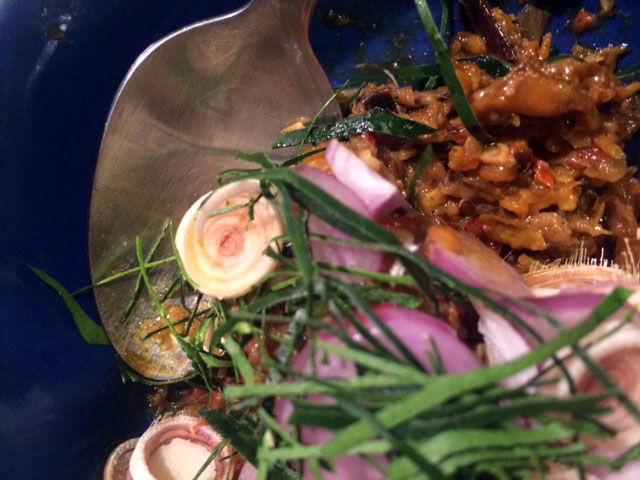ABOVE: ‘Pla Rah Sub’ (chopped pla rah) from Orawan at Aor Tor Kor
THAI FOOD 101 — It’s a smell that can’t be forgotten. When faced with their first whiff of the famously fermented fish delicacy known as pla rah, newcomers to Thailand commonly recoil in the kind of horror reserved for molting body parts or rotting animal carcasses. Under normal circumstances, it would be the kind of smell that tells you “OMG! Get to the doctor IMMEDIATELY!”
But to a select — and dwindling — number of Thais, it’s the smell of something delicious making its way to the table.
Like gapi (shrimp paste), pla rah is meant to serve as the baseline underpinning the flavors of every dish it is in. Unlike gapi, pla rah forms an important part of Northeastern Thai culinary culture, once part of every Isaan Thai’s repertoire of family recipes. Chin Chongtong of Chili Paste Tours, an Ubon Ratchathani native, remembers making pla rah with her grandmother and grandfather. There, pla rah was known as pla daek, meaning “chopped fish” in the local dialect. Good pla daek was so well-regarded that it was once used as currency in Isaan, tradable for chickens, pigs, or in special cases, a buffalo. Pla daek became pla rah when the fermented fish began to make an appearance in Central Thailand, where daek is considered an impolite term for “to eat.”
For Isaan people, pla daek symbolizes friends, family, happy relations,” Chin said. “When I was 6 years old, my Grandpa said to be careful of breaking the pla daek jar because it’s the same as you killing Isaan people! So I know that pla daekis very important for my culture.”

Pla rah juice getting doctored the Isaan way by Chin. Photo: @chilipastetour
The method of making your own pla rah may differ from family to family, but most cooks in Isaan consider pla chon (snakehead fish) to be the best fish to use (in Central Thailand, cooks use small fish which they keep whole). Any organs and extraneous parts such as the head are removed before the cut-up pieces are mixed with salt, rice bran and/or toasted rice kernels to “encourage”
the fish to sweat out its juices. These pieces are then placed in a jar for a year, during which cooks will periodically add more rice bran and take out the pieces to massage and remix them.
If that sounds like a lot of work, it is. There is also an abundance of rules for the budding pla rah connoisseur to remember, such as banning the use of sea salt and employing a wooden oar-like paddle to mix up the fish pieces every 10 days. What is left in the jar after 12 months of fermentation are tranches of disintegrating fish snippets awash in a pool of pungent liquid. It is this liquid that will be used to flavor almost every Isaan dish you can think of.
The best pla rah sauce is red in color; that is when you know that it has been aged for at least a year, Chin says. But sometimes it is impossible to procure your very own Isaan-made, ruby-colored, garbage-scented fermented fish juice. So what Chin does is buy her pla rah ready-made at Pak Chong Market and doctor it by boiling it over medium heat with pineapple, shrimp paste and tomatoes for about two hours. It is only then that Chin — who describes herself as “very picky” — deems her pla rah ready for the som tam (grated salad) mortar.

While som tam pla rah is one of the more popular ways to enjoy this fermented fish delicacy in the Thai capital, pla rah can make its presence felt in other ways too. In a land where there is a nam prik (chili dip) for everything, pla rah flesh is cooked and mixed with its juice, regular fish flesh, chilies, shallots, garlic, sugar and lime juice to form nam prik pla rah. And when mixed with coconut milk, it becomes a lohn (coconut milk-infused chili dip).
But my favorite way to eat pla rah might be the harder-to-find dish pla rah sub (chopped fermented fish), where the fish flesh and juice are mixed with finely minced lemongrass, chilies, shallots, garlic and mahgrood lime leaves before they are quickly sauté ed in a pan with some unscented oil and garnished with more lemongrass, shallots, and julienned lime leaves. It’s the flavor of the fermented fish, tamed for a farang-ish palate like mine.
As for where to find this dish? Check out Orawan in Aor Tor Kor, located opposite Mama Guay Chai in the first “aisle” of the market facing the road.
Don’t skip class! Check out more Thai Food 101:
What you wanted to ask about Thai Street Food but were afraid to know
Straight Outta Lanna: The khao soy connection
Just beat it: Laziness is killing our som tum flavor
If Game of Thrones was Thai street food
Satawesome or satawful: Reconsidering a troubled relationship with the stink bean
Catching the tail end of the summertime rice festival
Dr. Stinkfruit or: How to Stop Worrying and Love Durian
How to Yum: Make a tasty salad with whatever you got
Nam Prik 101: Is Thailand losing its pungent, chili paste heritage?




